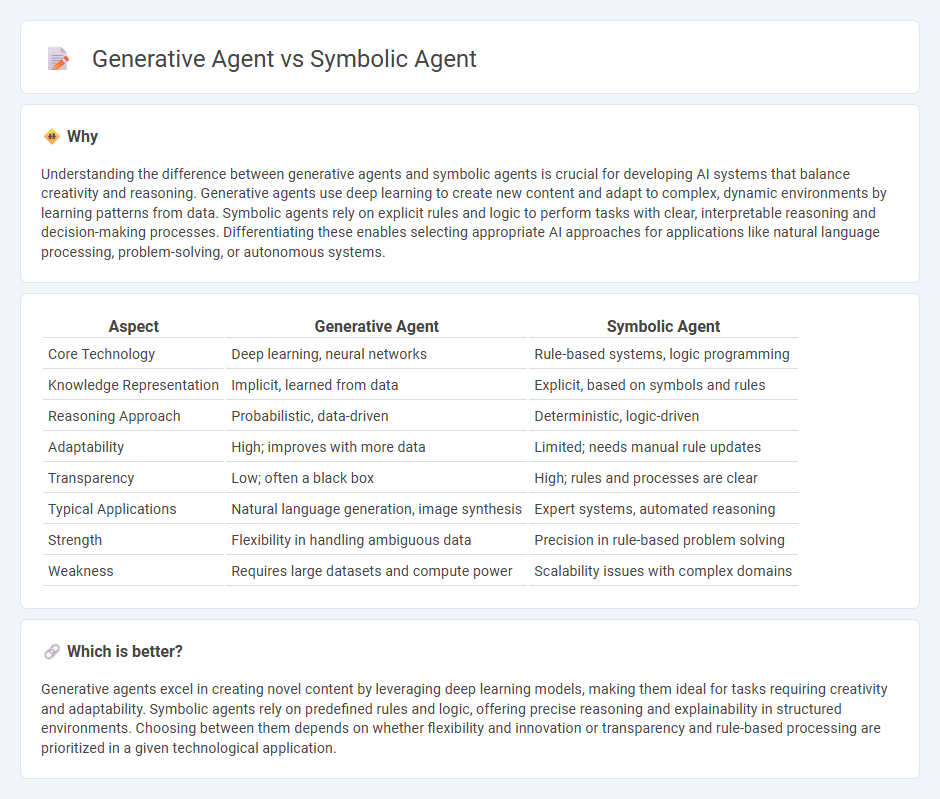
Generative agents leverage deep learning neural networks to create novel outputs by understanding data patterns, while symbolic agents operate using predefined rules and logical reasoning based on human-coded knowledge. Generative models excel in tasks like image synthesis and natural language generation, whereas symbolic agents are preferred for applications requiring explicit reasoning and explainability. Explore the advancements and applications of these contrasting AI paradigms to understand their impact on technology.
Why it is important
Understanding the difference between generative agents and symbolic agents is crucial for developing AI systems that balance creativity and reasoning. Generative agents use deep learning to create new content and adapt to complex, dynamic environments by learning patterns from data. Symbolic agents rely on explicit rules and logic to perform tasks with clear, interpretable reasoning and decision-making processes. Differentiating these enables selecting appropriate AI approaches for applications like natural language processing, problem-solving, or autonomous systems.
Comparison Table
| Aspect | Generative Agent | Symbolic Agent |
|---|---|---|
| Core Technology | Deep learning, neural networks | Rule-based systems, logic programming |
| Knowledge Representation | Implicit, learned from data | Explicit, based on symbols and rules |
| Reasoning Approach | Probabilistic, data-driven | Deterministic, logic-driven |
| Adaptability | High; improves with more data | Limited; needs manual rule updates |
| Transparency | Low; often a black box | High; rules and processes are clear |
| Typical Applications | Natural language generation, image synthesis | Expert systems, automated reasoning |
| Strength | Flexibility in handling ambiguous data | Precision in rule-based problem solving |
| Weakness | Requires large datasets and compute power | Scalability issues with complex domains |
Which is better?
Generative agents excel in creating novel content by leveraging deep learning models, making them ideal for tasks requiring creativity and adaptability. Symbolic agents rely on predefined rules and logic, offering precise reasoning and explainability in structured environments. Choosing between them depends on whether flexibility and innovation or transparency and rule-based processing are prioritized in a given technological application.
Connection
Generative agents and symbolic agents connect through their complementary approaches to artificial intelligence: generative agents use data-driven models like neural networks to create novel outputs, while symbolic agents use rule-based systems to perform logical reasoning and knowledge representation. Integrating these paradigms enhances AI systems by combining the creativity and learning capabilities of generative agents with the interpretability and structured problem-solving strengths of symbolic agents. This hybrid approach drives advancements in AI research, enabling more robust, adaptable, and explainable intelligent technologies.
Key Terms
Rule-based reasoning
Symbolic agents rely on rule-based reasoning by applying explicitly defined logic and symbolic representations to process information and make decisions, enabling precise and interpretable actions. Generative agents, in contrast, utilize machine learning models that generate behaviors based on learned patterns rather than predefined rules, often sacrificing transparency for adaptability. Explore the distinctions further to understand how rule-based reasoning shapes agent capabilities.
Machine learning
Symbolic agents rely on rule-based systems and explicit knowledge representation for decision-making, while generative agents utilize machine learning models that generate responses based on patterns learned from data. In machine learning, generative agents, such as those using neural networks and probabilistic models, enable adaptability and the creation of novel outputs from uncertain information, contrasting with the rigid structure of symbolic agents. Explore advanced machine learning techniques to understand how generative agents are transforming intelligent systems.
Emergent behavior
Symbolic agents rely on predefined rules and explicit knowledge representation, resulting in predictable behaviors with limited emergent properties. Generative agents utilize machine learning models and probabilistic frameworks that enable adaptive and spontaneous emergent behavior through dynamic interaction with their environment. Explore our detailed analysis to understand how emergent behavior differentiates symbolic and generative agents in AI development.
Source and External Links
What is Symbolic AI? - DataCamp - Symbolic agents in AI operate by representing knowledge through symbols and logical rules, enabling reasoning and decision-making based on explicit, interpretable logical inferences rather than numerical data.
Types of Agents | Continuum Labs - Symbolic agents function as knowledge-based expert systems that use predefined logical rules to solve complex problems with transparent reasoning but have limitations handling uncertainty and scaling to real-world complexity.
Symbolic Learning Enables Self-Evolving Agents - GitHub Pages - Symbolic agents can be designed as symbolic networks optimized by language-based symbolic learning frameworks, allowing them to self-evolve by updating their symbolic knowledge and reasoning without relying on numeric weights.
 dowidth.com
dowidth.com